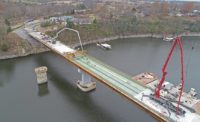Delicate operations are the rule, not the exception, at Cedars-Sinai Medical Center in Los Angeles. However, one of the procedures carried out recently didn’t involve any skillful surgeons or celebrity patients. The S. Mark Taper Foundation Imaging Center Renovation, which is replacing the unit’s magnetic resonance imaging (MRI) machine and its 18,000-lb magnet, required a delicate transplant of heavy equipment to ensure that the patient could live on and serve the community for years to come.
The machine “is in the center of the hospital, directly adjacent to the emergency department, with X-ray rooms on both sides and patients passing all around us,” says Lee Watkins, project manager of Pasadena-based general contractor C.W. Driver. Having been awarded three projects at Cedars-Sinai in October 2010, the firm also is remodeling the 6,000-sq-ft Thalians Mental Health Center and renovating the existing radio-frequency and X-ray equipment within the imaging center.
Selecting an exit route for the huge machine was the main challenge. The project’s structural consultant, San Francisco-based Degenkolb Engineers, studied four paths through the building “to determine which one was most cost-effective and least intrusive to hospital operations,” says Richard Franco, principal-in-charge. The team worked with a physicist who conducted a “scatter report” to find out if the walls surrounding the new machine in its 400-sq-ft room required extra lead shielding. They did.
No Exit
Even so, maneuvering the massive MRI magnet replacement posed the most challenges. To get the existing magnet out of the building, Watkins and his team had to map out pathways, conduct structural analysis on concrete floors and replace five doorways—all without disrupting the busy hospital. So that work can avoid affecting patients and staff, “we are literally working behind the scenes during nonpeak hours,” says Richard Freeark, C.W. Driver project executive.
When the original machine was installed eight years ago the room was built around it, says Michael Zakian, a principal with Culver City-based Zakian Woo Architects. The main obstruction in getting the magnet out was the doorways, which were too short and narrow for the roughly 4-ft-thick by 7-ft-tall solid block of machinery to fit through.
This is challenging because each door set was �like a separate project all by itself,� Zakian explains. Each had its set-ups, closures, material orders, fire marshal inspections and mounds of paperwork from the Office of Statewide Health Planning and Development. Tom Daly, Cedars-Sinai project manager, says the hospital employs two inspectors to work with OSHPD, whose inspectors pass through the unit every other week.
After the doorways were rebuilt in December, the old magnet was put on polycarbonate sheeting and slid 400 ft down hospital corridors like a patient on a gur-ney. Crews then moved the equipment out the front door, where it was hoisted on a truck. Like a still beating heart, the magnet had to be kept cool with chilled, circulating water to keep it from losing power during the move. Once unhooked from the machine, MRI magnets need to be reconnected in about 10 days to stay active, Daly says.
�We had to schedule everything perfectly,� Daly says, so that once disconnected, the magnet was on a truck to Chicago where it would be reconnected to power and water for a new owner. Once the old magnet was removed, the project team began adding new copper shielding to the room walls in preparation for the arrival of the new magnet in mid-March. A similar procedure will be used to install it.
C.W. Driver�s current enterprise comes on the heels of the company�s completion of two other projects at the Cedars-Sinai Medical Center. The builder recently completed construction of a 20,000-sq-ft, third-floor laboratory at the medical center�s Steven Spielberg Building, where 3D building information modeling was used to convert office space into a wet lab and make interiorseismic improvements.
The contractor also added braced-frame reinforcements to complete an exterior upgrade, along with an exterior building enhancement that included creating a 40-ft decorative screen to hide the newly installed exterior frames. In addition, the contractor also recently converted the existing cardiac suite to six operating rooms at the hospital�s 27,000-sq-ft, fifth floor post-anesthesia care unit.
Watkins says it�s �mind-boggling to think we crammed� about 87.5 tons of steel in this space to strengthen the existing structure �and then planted a 95-ton roof platform on top of that.�
Article toolbar





Post a comment to this article
Report Abusive Comment